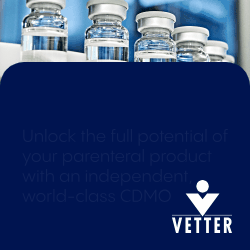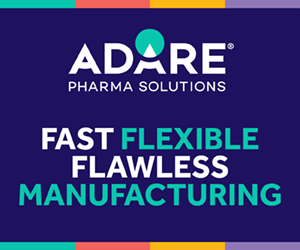Bioavailability & Solubility
Aenova expands its advanced technology portfolio with cutting-edge hot melt extrusion platform
Starnberg, Germany, Aenova, a leading global contract development and manufacturing organization (CDMO), relies on various innovative technologies to improve the oral bioavailability of poorly soluble…
BASF strengthens its commitment to the biopharma and pharmaceutical ingredients industries through a new investment in North America
New Good Manufacturing Practice (GMP) Solution Center in Wyandotte, Michigan expands BASF’s existing network of poloxamers sites Production capabilities are unique to industry and enable…
Lifecore Biomedical Signs New 10-Year Commercial Manufacturing and Supply Agreement with Key Existing Custome
CHASKA, Minn., Lifecore Biomedical, Inc., a fully integrated contract development and manufacturing organization (“CDMO”), today announced that it has signed a new 10-year commercial manufacturing…
Tiziana Life Sciences Expands Phase 2 Clinical Trial of Intranasal Foralumab With Commencement of First Patient Dosing
Tiziana Life Sciences, Ltd recently announces that dosing has commenced at the prestigious Weill Cornell Medicine Multiple Sclerosis Center in New York City, in its ongoing…
SPECIAL FEATURE- Outsourcing Formulation Development & Manufacturing: CDMOs Are Making Their Supply Chains More Resilient & Secure
Contributor Cindy H. Dubin speaks with many CDMO professionals to get their insights and perspectives on the current state of the industry.
FORMULATION FORUM - Manufacturing of Solid Oral Dosage Forms by Direct Compression
Jim Huang, PhD, and Shaukat Ali, PhD, say not all excipients are well suited for DC, so challenges remain to find excipients compatible to DC due to certain physicochemical properties associated with poor flowability, lack of plasticity, flexibility, and compressibility.
SPECIAL FEATURE - PFS & Parenteral Delivery: Innovation Is Focused on Patient-Centric, Smart & Sustainable Solutions
Contributor Cindy H. Dubin speaks with several innovating companies to discuss trends in PFS as well as advancements in autoinjectors and innovations in parenteral delivery.
Agno Pharma’s Particle Sciences, Inc. Achieves ISO 13485:2016 Certification
Agno Pharma recently announced its subsidiary, Particle Sciences, Inc., has earned ISO 13485:2016 certification from National Quality Assurance, U.S.A. (NQA). This achievement underscores Particle Sciences’…
SPECIAL FEATURE - Bioavailability & Solubility: The Promise of Novel Ingredients
Contributor Cindy H. Dubin, speaks with several innovating companies to discuss the use of novel excipients as well as other methods and technologies for tackling bioavailability and solubility once and for all.
FORMULATION FORUM - Lymphatic versus Portal Drug Delivery: An Understanding of Drug Oral Absorption & Food Effect
Jim Huang, PhD, and Shaukat Ali, PhD, say the lymphatic system is a distinctive route that is essential for drug transport and delivery of large and lipophilic molecules by alleviating the challenges in penetrating blood capillaries.
DRUG DEVELOPMENT - Improving Bioavailability & Solubility in OSDs
Hibreniguss Terefe, PhD, explores the options available to improve bioavailability and solubility and provides guidance to support decision-making when designing oral formulations for poorly soluble drug candidates in early development.
2025 COMPANY PROFILES & CAPABILITIES
For each participating company, this section presents a detailed summary highlighting their core technologies, capabilities, technologies, and services.
EXECUTIVE INTERVIEW - Lonza: Utilizing Analytical Tools & Predictive Models to De-Risk Drug Development
Drug Development & Delivery recently interviewed Josh Marsh, Bioavailability Enhancement and PBPK Lead Scientist at Lonza, to discuss the benefits of predictive tools and Lonza’s approach.
Arvinas & Pfizer Announce Initial Phase 1b Data From the TACTIVE-U Sub-Study of Vepdegestrant in Combination With Abemaciclib
Arvinas, Inc. and Pfizer Inc. recently announced preliminary data from the ongoing Phase 1b portion of the TACTIVE-U sub-study of vepdegestrant in combination with abemaciclib…
Ascendia Pharmaceutical Solutions Launched to Meet Drug Development & Manufacturing Needs
Jim Huang, Ph.D., founder and CEO of Ascendia Pharmaceuticals, announces that the pharmaceutical contract development and manufacturing organization (CDMO) has re-branded to Ascendia Pharmaceutical Solutions.…
Gattefossé Announces Inauguration of its New Premises & Technical Center of Excellence in Mumbai
India is a strategic country for the business development of the Gattefossé Group. To support this growing market, Gattefossé continues to invest in the opening…
Can-Fite Achieves Milestone With First Patient Dosing in Pancreatic Cancer Phase 2a Clinical Trial
Can-Fite BioPharma Ltd. recently announced the dosing of the first patient in the Phase 2a clinical trial in patients with advanced pancreatic adenocarcinoma (NCT06387342). “We…
Hovione & Zerion Pharma Create Joint Venture to Further Expand Use of Dispersome Technology
Hovione Farmaciência, S.A. and Zerion Pharma A/S recently announced they have expanded their partnership to accelerate the development of the Dispersome technology platform and further…
DRUG DELIVERY - Advancements in Transdermal Delivery Systems: A Focus on Invisicare® Technology for Obesity Treatment
James A. Roszell, PhD, and Doreen McMorran demonstrate how this technology has demonstrated potential in the transdermal administration of glucagon-like peptide-1 (GLP-1) agonists and cannabinoid receptor type 1 (CB-1) antagonists, primarily targeting obesity management and other conditions requiring glucose regulation.
FORMULATION FORUM - Lyophilization Technology - An Enabler for Stable Formulations of Small & Large Molecules
Shaukat Ali, PhD, and Jim Huang, PhD, explain how lyophilization or freeze-drying technology is one of the ideal methods that leads to immobilization of drug and other components that remain in solid or powder state for extended periods without concerns of degradation, and how it has also been applied to improve drug solubility by means of amorphous solid dispersions.
Bioavailability and Solubility Challenges
Given that a large number of drugs fail to reach the market due to poor solubility and bioavailability, the industry is seeking various methods to mitigate this challenge while many choose to re-formulate existing product candidates. Either way, the demand for novel bioavailability and solubility enhancement methods has grown significantly. To cater to this increasing demand, many contract manufacturers and technology developers have emerged.
What is Solubility?
Solubility is the ability for a drug to be dissolved in an aqueous medium. Drug solubility is defined as the maximum concentration of a substance that can be completely dissolved in a given solvent at a certain temperature and pressure level.
Solubility of drugs is measured by the amount of solvent needed to dissolve one gram of the drug at a specific temperature. For example, a drug that is very soluble needs less than one part solvent to dissolve one gram of the drug. How soluble a drug is varies widely—a drug that is considered soluble needs 10-30 parts, one that is slightly soluble needs 100-1,000 parts and one that is practically insoluble or insoluble needs more than 10,000 parts. How soluble a drug is depends on the solvent, as well as temperature and pressure.
Since 1975, approximately 60 marketed drugs have leveraged solubilization technologies to enhance oral bioavailability. In the preceding 36 years, from the time the FDA required submission of an NDA in 1938, solubilization technology was virtually unused on a regular basis. Apparently, the disease areas focus, drug discovery methodologies, and the lack of mature solubilization platforms restricted the use prior to the 1970s.
In comparison, the past nearly 4 decades have shown robust growth in the reliance on solubilization platforms, accounting on average for around 9% of all NMEs approved from 1975 through 2022, and more than 10% in the past decade. Some years stand out to validate the need and use of solubilization platforms. For example, in 2005, 20% of NMEs approved used technologies including solid dispersion, lipid, and nanocrystal platforms. The data for the most recent 4-year period (2010-2013) seems to represent a slight decline in growth, but it is still early in the decade, and the data set is relatively small. Based on the trends throughout the past 4 decades and the changing chemical space in drug development, we expect the decade will show additional and significant current growth in use of solubilization technologies once we have visibility into the full 10-year period.
Bioavailability & Solubility Impediments
The biggest impediment in addressing bioavailability issues likely lies with a lack of deep familiarity with enabling technologies. Improving drug bioavailability begins with a thorough evaluation of the API’s physical and chemical properties in relation to solubilization in the dose, but more importantly its dissolution in vivo at the site of absorption.
These technologies, such as nanoparticles, cocrystals, computer-aided prodrug design, and electrospinning, represent innovations aimed at enhancing the solubility of a candidate molecule, particularly in the gastrointestinal tract. Technologies such as electrospinning, deep eutectic solvents, and ionic liquids are upcoming formulation approaches to enhance drug solubility, and as the science matures, and the relative strengths and weaknesses are better understood, we expect to see further application of these innovative approaches. They have shown to be successful for some compounds, and have a place alongside other bioavailability enhancement technologies, where each strategy has its benefits and corresponding liabilities. For them to be successful and widely adopted however, they will also have to provide a compelling benefit compared with other well-understood, and commercially precedented technologies, such as amorphous solid dispersions and lipid-based formulations.
Extreme compounds require either significant amounts of stabilizers to maintain the amorphous state or they are not amenable to common manufacturing technologies with reasonable cost of goods due to their low solubility in organic solvents. These include amorphous solid dispersions using polymethacrylate, cellulose, or povidone-based polymeric carriers, she says. In addition, thermostability of new molecular entities becomes an issue as most new molecules have melting points well above 400°F. Alternative production methods for amorphous solid dispersions can address these issues.










